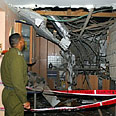
Looking at the southern town of Ashkelon from a bird’s eye view reveals many red roofs, particularly along the sea. In the older neighborhoods you would find a concrete mess that was not built to withstand a collision with a flying pipe, and old houses, mostly from the 50s and 60s of the previous century.
More than 100,000 people live in Ashkelon today. Should the Palestinian Grad missile do to this town what the Qassam rocket did to Sderot, soon there would be only 90,000 people living here. Hamas would grow the more Ashkelon shrinks. But here, for the time being, repression is the name of the game.
During a recent government session, one of the two ministers who reside in Ashkelon, Avi Dichter, warned that his town would soon join the circle of death resulting from airborne terrorism. “Instead of 25,000, soon we will have 250,000 Israelis living under the threat of Palestinian rockets,” he cautioned. Every morning, he hears from his home the helicopters rushing to the morning ambush on the Gaza Strip border.
Yet aside from him and from his neighbor, Yitzhak Cohen from Shas, does anybody hear anything in Jerusalem? Ehud “we won’t fortify ourselves to death” Olmert? Shaul “after the disengagement we would powerfully hit anyone who would dare fire rockets” Mofaz? Ehud “the road to stopping the Qassams is still long” Barak? Ami “we shouldn’t attack Gaza now, it would weaken Abbas” Ayalon?
Thursday morning, I visited Ashkelon’s open market. Hundreds of busy residents already gathered at the large compound. During the day, 10,000 people or possibly more than that would arrive at the intoxicating vegetable and fruit stands. They prefer the magic of the open market – it is both fresher and cheaper. Yet the only thing separating them from the Grad missile at this time is Hamas leader Khaled Mashal’s decision, and the canvas above the stands.
Absolute tranquility
In terms of their range, as was proven when a Qassam rocket hit a school about two and a half years ago, the rockets would soon sow death here. But why should I worry about rockets now, asks the average Ashkelon resident. The mayor, in coordination with the Home Front Command, is not yet willing to connect his town to the “Color Red” alert system; he does not want panic at this time. It would make people flee the town and bring housing prices down. It would reinforce the sad image of the town near Gaza.
For now, it’s working for him and for them. Residents are repressing, maintaining a beachfront routine, as if their town was on the French Riviera. People are going down to the market, others get a breath of fresh air in the beautiful marina and going out to see and be seen wearing their best clothes at the lovely seafront promenade. The waves are calm, the seafood at the restaurants is delicious, and prices are decent. People are talking about the local soccer team, not about the Grad. Soccer is much more interesting than Abbas and Ismail Haniyeh. Absolute tranquility.
Only if they look south, they would see the rocket-alerting zeppelin above the borderline community of Netiv Ha’asara, the gunships awaiting the latest rocket launching cell, the Rotenberg power station that has been repeatedly targeted by rockets, and the skies above Gaza, the place of death and terror.
Yet nobody is looking up, or ahead to tomorrow. In Ashkelon they see everything, aside from the day that is about to come, the day of the bomb. And if they can’t see it from Ashkelon, why do we expect them to see it from Jerusalem?















